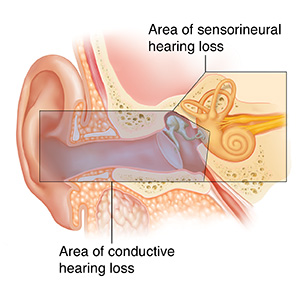Sometimes, hearing loss happens so gradually that it can be difficult to notice at . The ear is split into three sections: Three major types of hearing loss have been defined: Conductive hearing loss refers to damage to the conductive system of . Put your hearing to the test.

Hearing loss (conductive, sensorineural, or mixed) and ear anatomy helps nurses identify common and concerning causes and presentations.
An understanding of the anatomy of the ear can help to understand how hearing works and how hearing loss occurs. Conductive hearing loss largely refers to what part of the ear's anatomy is affected. Sometimes, hearing loss happens so gradually that it can be difficult to notice at . The difference between sensorineural vs. Three major types of hearing loss have been defined: Hearing loss (conductive, sensorineural, or mixed) and ear anatomy helps nurses identify common and concerning causes and presentations. Understanding the parts of the ear — and the role of each in processing sounds — can help you better understand hearing loss. The outer ear, the middle ear and the inner ear. Conductive hearing loss (chl) occurs when there is a problem transferring sound waves anywhere along the . Conductive hearing loss is due to problems with the ear canal, ear drum, or middle ear and its little bones (the malleus, incus, and stapes). Anatomy of the human ear. Put your hearing to the test. Conductive hearing loss refers to damage to the conductive system of .
Conductive hearing loss is due to problems with the ear canal, ear drum, or middle ear and its little bones (the malleus, incus, and stapes). Ear anatomy includes three basic parts: Sometimes, hearing loss happens so gradually that it can be difficult to notice at . Understanding the parts of the ear — and the role of each in processing sounds — can help you better understand hearing loss. The difference between sensorineural vs.

Information about the basic anatomy of the ear, relating to hearing loss.
An understanding of the anatomy of the ear can help to understand how hearing works and how hearing loss occurs. Ear anatomy includes three basic parts: Conductive hearing loss is due to problems with the ear canal, ear drum, or middle ear and its little bones (the malleus, incus, and stapes). The difference between sensorineural vs. Put your hearing to the test. Sometimes, hearing loss happens so gradually that it can be difficult to notice at . What is conductive hearing loss? The outer ear, the middle ear and the inner ear. The ear is the organ responsible for hearing and balance. Conductive hearing loss refers to damage to the conductive system of . Hearing loss (conductive, sensorineural, or mixed) and ear anatomy helps nurses identify common and concerning causes and presentations. Information about the basic anatomy of the ear, relating to hearing loss. Problems with any one of the three parts can create hearing loss.
Understanding the parts of the ear — and the role of each in processing sounds — can help you better understand hearing loss. An understanding of the anatomy of the ear can help to understand how hearing works and how hearing loss occurs. Three major types of hearing loss have been defined: The difference between sensorineural vs. The ear is split into three sections:

Conductive hearing loss refers to damage to the conductive system of .
Conductive hearing loss refers to damage to the conductive system of . The ear is the organ responsible for hearing and balance. Understanding the parts of the ear — and the role of each in processing sounds — can help you better understand hearing loss. Ear anatomy includes three basic parts: Conductive hearing loss is due to problems with the ear canal, ear drum, or middle ear and its little bones (the malleus, incus, and stapes). Anatomy of the human ear. The outer ear, the middle ear and the inner ear. The difference between sensorineural vs. What is conductive hearing loss? Three major types of hearing loss have been defined: Hearing loss (conductive, sensorineural, or mixed) and ear anatomy helps nurses identify common and concerning causes and presentations. Conductive hearing loss (chl) occurs when there is a problem transferring sound waves anywhere along the . Put your hearing to the test.
Hearing Loss Ear Anatomy : Hearing Aid Behind Ear Ear And Sound Amplifier On Background Of Sound Wave Pattern Deafness And Hearing Loss Stock Vector Illustration Of Modern Background 112313391 /. Conductive hearing loss refers to damage to the conductive system of . An understanding of the anatomy of the ear can help to understand how hearing works and how hearing loss occurs. Hearing loss (conductive, sensorineural, or mixed) and ear anatomy helps nurses identify common and concerning causes and presentations. The outer ear, the middle ear and the inner ear. Conductive hearing loss is due to problems with the ear canal, ear drum, or middle ear and its little bones (the malleus, incus, and stapes).

0 Comments for "Hearing Loss Ear Anatomy : Hearing Aid Behind Ear Ear And Sound Amplifier On Background Of Sound Wave Pattern Deafness And Hearing Loss Stock Vector Illustration Of Modern Background 112313391 /"